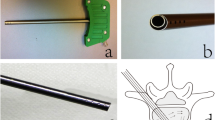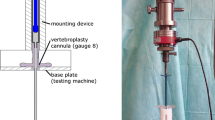Abstract
Purpose
In the last 15 years, vertebroplasty and kyphoplasty have become established operative procedures for treating osteoporotic vertebral-body fractures and vertebral bodies afflicted with metastases. These procedures are quickly performed with few personnel and material resources and have a low rate of complications. However, cases of neurological impairment are reported in the scientific literature. We analysed whether potentially harmful heat is radiated/conducted by the polymerisation temperature of polymethylmethacrylate (PMMA) bone cement in the spinal canal.
Methods
We performed vertebroplasty on 25 vertebral bodies and measured the temperature distribution during polymerisation of bone cement within the spinal canal using heat probes placed in the respective areas. The vertebral bodies were located in a circulating water bath at 37°C.
Results
During polymerisation of the bone cement, a temperature rise was measured. The peak temperature was reached after few minutes. Temperature curves differed; a maximum temperature of up to 43.16°C was detected for a few seconds only.
Conclusion
When vertebroplasty is performed correctly, there is no temperature development that could eventually damage the spinal cord or spinal nerves.






Similar content being viewed by others
References
Birkenmaier C, Seitz S, Wegener B, Glaser C, Ruge MI, von Liebe A (2007) Acute paraplegia after vertebroplasty caused by epidural hemorrhage. A case report. J Bone Joint Surg Am 89:1827–1831
Gangi A, Dietemann JL, Guth S, Steib JP, Roy C (1999) CT- and fluoroscopy- guided Vertebroplasty: Results and Complications in 187 Patients. Semin Intervent Radiol 16:137–142
Harrington KD (2001) Major neurological complications following percutaneous vertebroplasty with polymethylmethacrylate: a case report. J Bone Joint Surg Am 83:1070–1073
Ratliff J, Nguyen T, Heiss J (2001) Root and spinal cord compression from methylmethacrylate vertebroplasty. Spine 26:E300–E302
Dewey WC (1994) Arrhenius relationship from the molecule and cell to the clinic. Int J Hyperthermia 10:457–483
Field SB, Morris CC (1983) The relationship between heating time and temperature: its relevance to clinical hyperthermia Radiotherapy and oncology. Radiother Oncol 1:179–186
De Vrind HH, Wondergem J, Haveman J (1992) Hyperthermia- induced damage to rat sciatic nerve assessed in vivo with functional methods and with electrophysiology. J Neurosci Methods 45:165–174
Stanczyk M, van Rietbergen B (2004) Thermal analysis of bone cement polymerisation at the cement- bone interface. J Biomech 37:1803–1810
Li S, Chien S, Branemark PI (1999) Heat shock- induced necrosis and apoptosis in osteoblasts. J Orthop Res 17:891–899
Toksvig-Larsen S, Johnsson R, Strömqvist B (1995) Heat generation and heat protection in methylmethacrylate cementation of vertebral bodies. Eur Spine J 4:15–1
Wilkes RA, Mackinnon JG, Thomas WG (1994) Neurological deterioration after cement injection into a vertebral body. J Bone Joint Surg Br 76:155
Deramond H, Wright NT, Belkoff SM (1999) Temperature elevation caused by bone cement polymerization during vertebroplasty. Bone 25(Suppl 2):17–21
Sminia P, Hendriks JJ, van der Kracht A, Rodernand H, Honvemann J, Jansen W (1995) Neurological observations after local irritations and hyperthermia of rat lumbosacral spinal cord. Int J Radiat Oncol Biol Phys 32:165–174
Franken NA, De Vrind HH, Sminia P, Havemann J, Troost D, Gonzalez Gonzalez D (1995) Neurological complications after 434 MHz microwave hyperthermia on the rat lumbar region including the spinal cord. Int J Radiat Biol 62:229–238
Uchiyama S, Yashiro K, Takahashi H, Homma T (1989) An experimental study of spinal cord evoked potentials and histologic changes following spinal cord heating. Spine 14:1215–1219
Konno S, Olmarker K, Byrod G, Nordborg C, Strömqvist B, Rydevik B (1994) Acute thermal nerve root injury. Eur Spine J 3:299–302
Fajardo LF (1984) Pathological effects of hyperthermia in normal tissues. Cancer Res 44(Suppl):4826s–4836s
Brown SA, Bargar WL (1984) The influence of temperature and specimen size on the flexural properties of PMMA bone cement. J Biomater Res 18:523–536
Dunne NJ, Orr JF (2002) Curing characteristics of acrylic bone cement. J Mater Sci Mater Med 13:17–22
Leeson MC, Lippit SB (1993) Thermal aspects of theil use of polymethylmethacrylate in large metaphyseal defects in bone: a clinical review and laboratory study. Clin Orthop Relat Res 295:239–245
Li C, Mason J, Yakimicki D (2004) Thermal charakterization of PMMA- based cement curing. J Mater Sci Mater Med 15:85–89
Gangi A, Guth S, Imbert JP, Marin H, Dietemann JL (2003) Percutaneous vertebroplasty: Indications, Technique and results. Radiographics 23:e10
Muto M, Muto E, Izzo R, Diano AA, Lavanga A, Di Furia U (2005) Vertebroplasty in the treatment of back pain. Radiol Med 109:208–219
Belkoff SM, Molloy S (2003) Temperature measurements during polymerisation of polymethylmetacrylate cement used for vertebroplasty. Spine 28:1555–1559
Aebli N, Goss BG, Thorpe P, Williams R, Krebs J (2006) In vivo temperature profile of intervertebral discs and vertebral endplates during Vertebroplasty: an experimental study in sheep. Spine 31(15):1674–1678
Acknowledgments
We thank the Biomet Deutschland GmbH for financial support of this study. The company had no influence on study design and results. The authors express their gratitude to Mr. Peter Dirschedl for his statistical consulting.
Author information
Authors and Affiliations
Corresponding author
Rights and permissions
About this article
Cite this article
Wegener, B., Zolyniak, N., Gülecyüz, M.F. et al. Heat distribution of polymerisation temperature of bone cement on the spinal canal during vertebroplasty. International Orthopaedics (SICOT) 36, 1025–1030 (2012). https://doi.org/10.1007/s00264-011-1382-8
Received:
Accepted:
Published:
Issue Date:
DOI: https://doi.org/10.1007/s00264-011-1382-8




